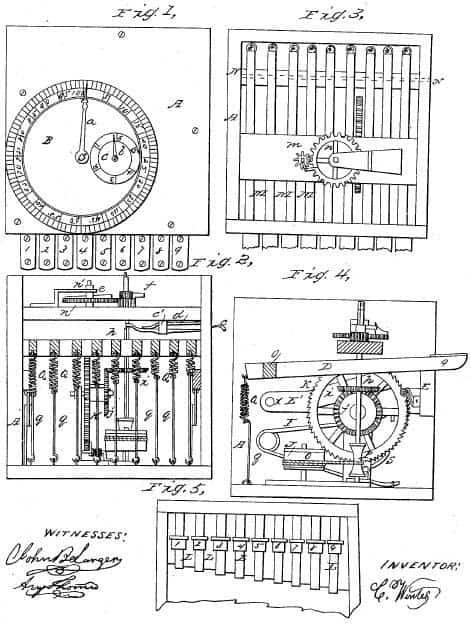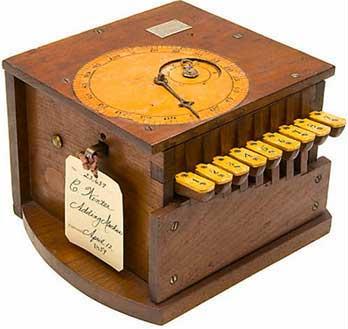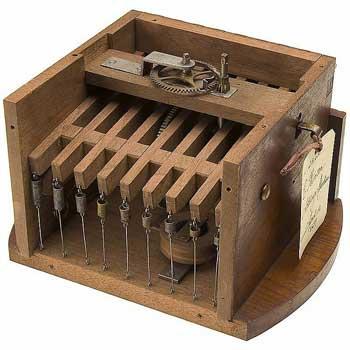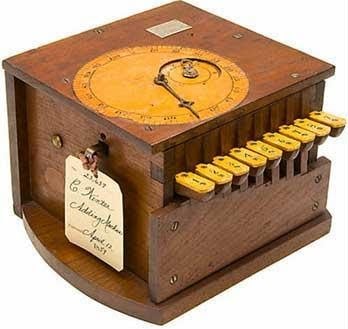3 Facts about Winter’s Keyboard Adder
- Winter’s Keyboard Adder is the first, and so far the only, mechanical calculator that was created and patented by a woman.
- Winter’s machine survived to modern times in the current form in which it was invented. Other original calculating machines did not continue as patented.
- Caroline Winter’s device was sold in an auction for $46,480 through the Auction Team Breker, Koeln, Germany in 2009.
Winter’s Keyboard Adder History
On April 12, 1859, Caroline Winter presented her Keyboard, which was called an “Improved Adding Machine” to the patent office. Winter received a three-page patent for the device. USA patent №23637 for a single-column adding device that was officially named “Improved Adding Machine.”
This particular machine came after a few other types had already been invented in the United States. These were Du Bois D. Parmelee’s in 1850, Orlando Lane Castle’s in 1857, and Leonard Nutz’s in 1858. Winter’s machine was a simple adding machine with single-column keys. It offered a secure and straightforward process that only needed a minimal amount of components to work effectively.
Quick Facts
- Created
- April 12, 1859
- Creator (person)
- Caroline Winter
- Original Use
- Facilitate calculations
- Cost
- Unknown
Winter used the elementary switching latch in a particular way that made this feature one of its defining characteristics. This specific latch, which was a special mechanism in the machine, had only been in a few other previous calculating machines. One such example using this type of switching latch was an invention by Jean-Baptiste Schwilgue.
Not much is known about Caroline Winter. She was the daughter of John Winter and was from Miami County in Ohio. She ran a store in Piqua, Ohio, and was mentioned in the Piqua business directories in 1859-60 and 1860-61 as the owner of a general store. She died on November 6, 1875.

This is the first page from Caroline Winter’s patent drawing.
Winter’s Keyboard Adder: How It Worked
The adding machine is a square, cube-shaped box made primarily of wood, specifically oak. It was made with ivory key taps and two dial faces on top of registers. The front has keys to push while the back is not covered, with the mechanical construction of the device open to easy viewing. The overall size of the machine is 27 x 22 x 25 cm.
The base of the internal calculating mechanism is a ratchet-style wheel that has 100 teeth, a cord, a pulley, bevel wheels, and pawls. The machine is able to calculate numbers up to 600 and it will provide the results with two different indicators. The bigger of two separate gauges can display numbers 1 to 100. A smaller gauge on the machine has an indicator for the hundreds that move continuously and shows numbers 1 through 6. The overall calculating capacity of the machine is up to 699.
The machine also has a resetting mechanism that is completed with a lever having its fulcrum slotted to easily embrace a shaft with a groove. The machine doesn’t have a tens carry mechanism but doesn’t need it to function effectively.
This is because a smaller ratchet-wheel (that counts hundreds), is rotating in proportion to a larger ratchet-wheel (that counts 1 through 99). It’s important to note that when computing the addition of multi-digit numbers, carrying tens needs to be done manually. This is described in the patent application.
Caroline Winter invented the machine to help with the tedious calculations in the store she operated. It was actually written in the patent, “It will be perceived that by the use of this machine, figures may be added rapidly and always with perfect correctness.”


Winter’s Keyboard Adder: Historical Significance
Winter’s keyboard adder was historically significant because it was invented by a woman, and to date, it is the only mechanical keyboard of its kind to be made and patented by a woman. Caroline Winter’s machine survived beyond the other machines such as Castle and Parmelee. By the early 2000s, the Keyboard Adder was owned by Auction Team Breker, Koeln, Germany. It was sold for $46,480 in 2009 to a European museum.
The National Museum of American History states that in the early twentieth century, several companies manufactured a variety of keyboard-adding machines. The 1920s and 1930s were the time period that saw an explosion of new adding devices. Caroline Winter and her keyboard adder were almost certainly an inspiration for many of the adding devices and even more advanced calculating machines that would follow.
A few decades after Caroline Winter’s historical invention, there were machines such as the one invented by William Seward Burroughs. In 1884 Burroughs developed not the first calculator, but the first mainstream calculator that essentially dominated the market at the current time. Burroughs adding machine was a counting machine used by thousands of business owners and shopkeepers.

